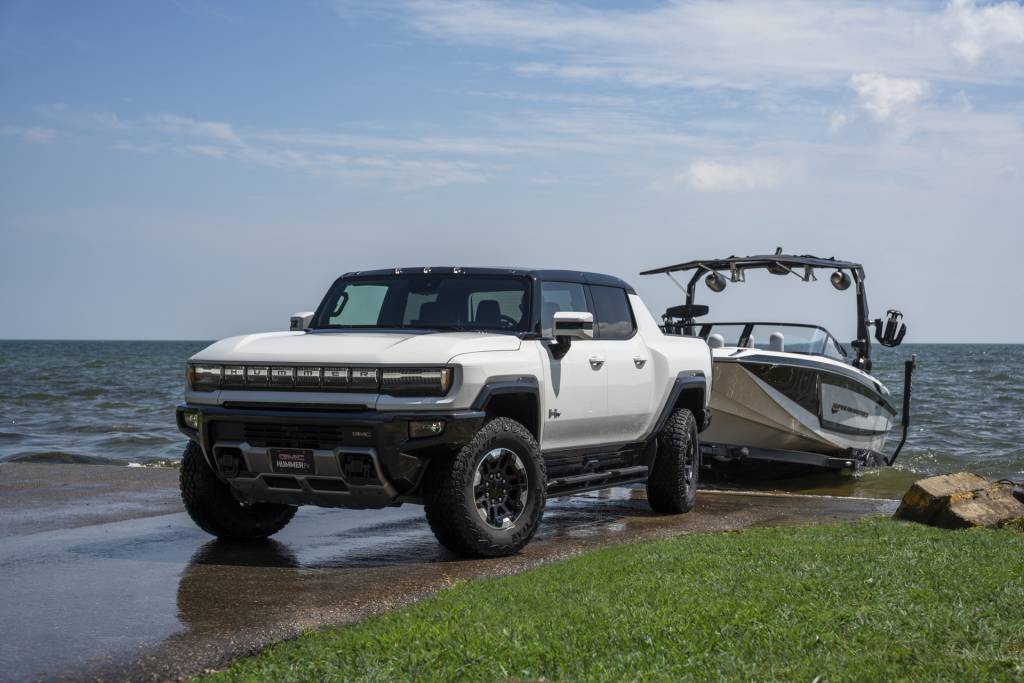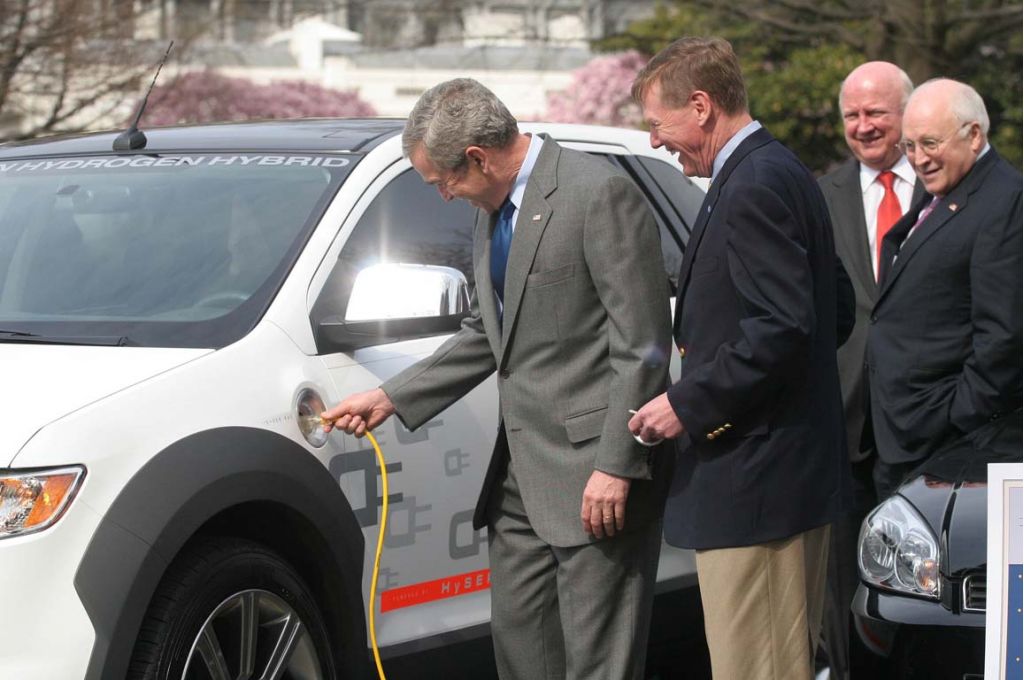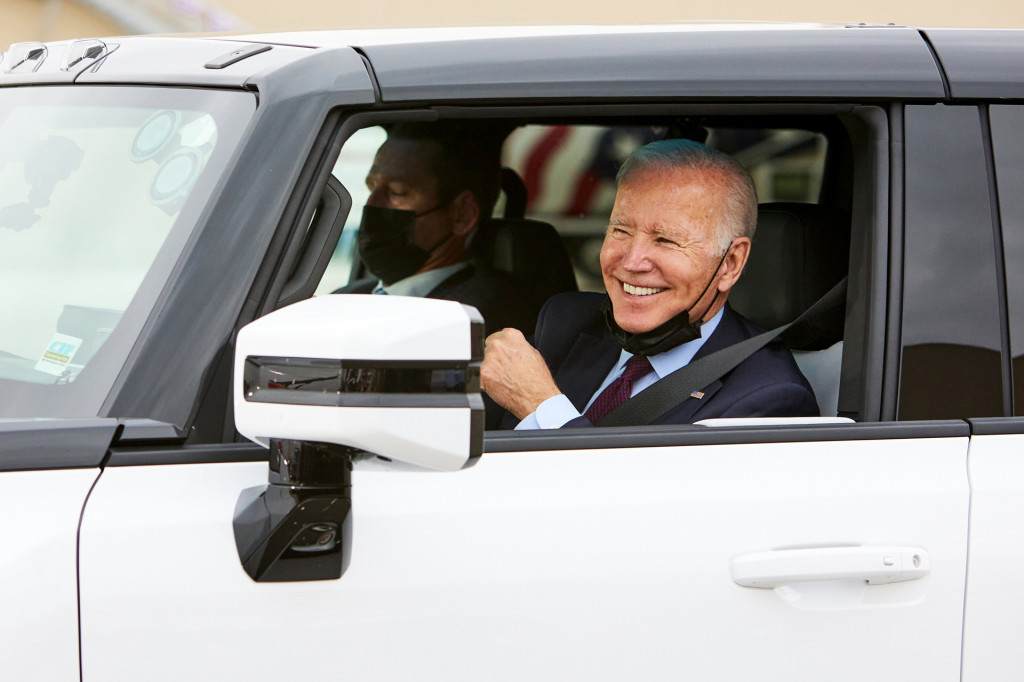

When did Republicans turn against EVs, and will the tide turn?
EV bashing has become a regular Republican position and talking point, but it hasn’t always been this way.
In a recent InsideEVs article, Detroit-based Republican and campaign consultant Mike Murphy discussed the results of a poll of 600 voters on EVs. Like many other current political issues, it shows a deep partisan divide, in this case with Republicans vehemently against EVs.
There are some predictable reasons for this, as Murphy notes. EVs are still closely tied to climate-change policy, so Republicans’ views of them are shaped by general hostility toward the concept of climate change itself.

2023 GMC Hummer EV Pickup
As Green Car Reports has explained many times before, EVs used to exist as a potential that stood for energy independence and the smart use of innovation, both of which appealed to fiscal-hawk conservatives.
Surveys as recently as 2019 showed that EVs weren’t really so polarizing, and several polls since then have still found bipartisan support among Americans for policies supporting EV adoption. However the elected officials representing them have indicated otherwise.
Anti-EV rhetoric started taking root in the GOP more than a decade ago. In a 2012 presidential debate, Mitt Romney called Tesla a “loser” company, implying that EV manufacturers couldn’t survive without government support. Tesla proved that wrong, and it was not a position that GOP party members stood behind in rank and file. But later in the decade, Trump’s derision of EVs became a perennial talking point and speech fodder.
So when did Republicans turn so strongly against EVs? GCR asked Murphy.

President Bush 2007
“I think it is all part of the tribalism that has eaten our politics,” he told Green Car Reports this week. “The minute the Democrats began politically defining themselves as the green energy party there was a growing knee-jerk response from the GOP: ‘if they are for this stuff, we are against it.'”
“Now EVs, which were initially sold by the industry as an environmental statement have become swept up in all that, and in the Trump era the whole feedback loop has been amplified,” he added. “Now EVs are no longer seen simply as vehicles to much of the GOP faithful, but instead as Biden/Democratic proxy-mobiles.”

President Joe Biden with the 2022 GMC Hummer EV
EVs aren’t the only thing to receive government funding in the hope of fostering energy independence. As Murphy pointed out in the State of Charge podcast, from GCR alum and charging expert Tom Moloughney (see below for the full episode), the ethanol industry has also received substantial government support far greater than EV support, for example, with some Republicans having no issue standing behind that. But all the spending under Biden likely didn’t help the situation with Republican voters.
That said, it’s puzzling why the Republicans in the Battery Belt, in the Southeastern states, have been seeking to block EV mandates that are bringing manufacturing jobs to their region. Meanwhile, EV adoption is becoming more polarized by state—partly because of a series of policy choices made by Republican lawmakers.
If it all seems hopeless, Murphy did point out that some of the old pragmatic conservative values may remain beneath all the toxic talk. Last year, when 18 GOP state governors authored a letter allying with car dealers in protesting Biden EV targets, neither Georgia governor Brian Kemp nor Tennessee governor Bill Lee were a part of it. Biden EV policy has been a boon to jobs and the economies in those states, and that may be the best hope that the tide will turn.

Kia EV manufacturing in Georgia
All while GOP politicians complain about the policies, there are continued indications that their constituency isn’t so decidedly negative about them. In Murphy’s poll, 27% of Democrats ranked the “rebate from the government” either the best or next-best reason to buy or lease and EV. For Republicans, that was 24%.
“Republicans are nearly just as happy to get an EV subsidy check as Democrats,” Murphy summed.

with reporting by Stephen Edelstein and Bengt Halvorson
function getYTImageResolution() {
if (window.matchMedia(‘(max-width: 325px)’).matches) {
return ‘mqdefault.jpg’;
} else if (window.matchMedia(‘(max-width: 640px)’).matches) {
return ‘sddefault.jpg’;
} else if (window.matchMedia(‘(max-width: 960px)’).matches) {
return ‘maxresdefault.jpg’;
} else {
return ‘maxresdefault.jpg’;
}
}
function runYTPlayer(elem) {
var iframePlayer = document.createElement(‘iframe’);
iframePlayer.src = elem.dataset.ytsrc + ‘?autoplay=1’;
iframePlayer.setAttribute(‘frameborder’, ‘0’);
iframePlayer.setAttribute(‘allow’, ‘autoplay; fullscreen’);
iframePlayer.mute=’1′;
iframePlayer.id=’videoPlayerYouTube’;
iframePlayer.width=elem.dataset.ytwidth;
iframePlayer.height=elem.dataset.ytheight;
elem.parentNode.replaceChild(iframePlayer, elem);
}
function initYouTubeVideos() {
var playerElement = document.getElementById(‘video-container’),
thumbNode = document.createElement(‘img’),
imgResolution = getYTImageResolution(),
videpId = playerElement.dataset.ytid;
// create YT image element
thumbNode.src=’https://img.youtube.com/vi/’ + videpId + ‘/’ + imgResolution;
thumbNode.loading=’lazy’;
thumbNode.width=playerElement.offsetWidth;
// create play button
var playButton = document.createElement(‘div’);
playButton.setAttribute(‘class’, ’embed-video-btn’);
// craete video circle
var playCircl = document.createElement(‘span’);
playCircl.setAttribute(‘class’, ‘play-icon fas fa-play-circle’);
// attach each other
playButton.appendChild(playCircl);
playerElement.appendChild(playButton);
playerElement.onclick = function () {
runYTPlayer(this);
};
playerElement.appendChild(thumbNode);
}
document.addEventListener(‘DOMContentLoaded’, initYouTubeVideos);
Add a comment Cancel reply
Related posts


Electric SUVs: Top 6 Models for Family Trips











